
Goal Setting Module
- Subject:
- Education
- Material Type:
- Homework/Assignment
- Lecture Notes
- Lesson
- Module
- Reading
- Textbook
- Date Added:
- 11/08/2017


Goal Setting Module
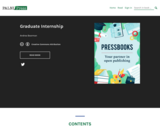
Course Description:
This graduate course is designed to combine classroom theory with practical application through job-related experiences. Students are actively employed in diverse organizations and agencies that relate to their graduate academic training and career objectives. Students will create obtainable SMART goals that apply to their personal and professional goals. Students will build skills related to interviewing etiquette to assist in successful job acquisition. Additionally, students will have the opportunity to reflect on supervisor feedback and their overall experience in the graduate internship.
Learning Outcomes:
Create achievable SMART goals. (LO1)
Connect academic knowledge with a professional setting. (LO2)
Recommend etiquette for professional interviews. (LO3)
Evaluate personal accomplishments and experiences related to master’s program of study. (LO4)
Analyze how to achieve professional growth in industry. (LO5)
Reflect on feedback provided by supervisor. (LO6)

Through the Story of a Slow Cat
Short Description:
This concise, open textbook weaves the story of a cat throughout to explain the research components of typical education research projects.
Long Description:
This book is designed to facilitate understanding of education research and guide the development and the writing of a research project. In education, like other social sciences, we are investigating issues directly involving or influencing humans. Research involving humans can be a complex and awkward endeavor. However, if we view this endeavor through the lens of a research story, we find a familiar genre we can relate to and understand. This concise, open textbook weaves the story of a cat throughout to explain the research components of typical education research projects.
Word Count: 16875
(Note: This resource's metadata has been created automatically by reformatting and/or combining the information that the author initially provided as part of a bulk import process.)
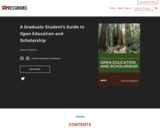
This openly licensed e-book provides an introduction to open education and scholarship for graduate students in all disciplines. In addition to providing introductory overviews of open education, open licenses, OER, open pedagogy, open access, open science, and open data, the guide offers advice and insights on how to establish oneself as an early-career open practitioner in higher education.

A project-based approach
Short Description:
This textbook guides graduate students in education step by step through the research process from conceptualization to dissemination. Recommended citation: DeCarlo, M., Cummings, C., Agnelli, K., & Laitsch, D. (2022, June 28). Graduate research methods in education (leadership): A project-based approach (Version 2.12.14.17-19.22). BC Campus. https://pressbooks.bccampus.ca/dlaitsch/
Word Count: 276805
(Note: This resource's metadata has been created automatically by reformatting and/or combining the information that the author initially provided as part of a bulk import process.)

This book has moved to https://pressbooks.bccampus.ca/dlaitsch.
Short Description:
This textbook guides graduate students in education step by step through the research process from conceptualization to dissemination.
Word Count: 276947
(Note: This resource's metadata has been created automatically by reformatting and/or combining the information that the author initially provided as part of a bulk import process.)

Digitally accessible, visually appealing courses
Short Description:
This book was written to help educators and instructional designers to design visually appealing courses (and curricular materials) that are also digitally accessible. I argue that applying graphic design principles reduces barriers, lowers cognitive load, and improves learning. I created the Graphic Design E-Learning Checklist to help instructional designers improve the look and feel of their courses while designing for inclusivity at the forefront.
Long Description:
In Graphic Design for Course Creators you will read about how to use and apply graphic design theory to improve the look, feel, and usability of your courses. You will also learn how to improve the digital accessibility of your courses while making strong design choices backed by learning science. For example, by learning the differences between images that aid in instruction and those considered seductive details, you will improve the learning experience of your students. Additionally, tips on selecting and combining colors will help you communicate appropriately while learning how to use color contrast will ensure more learners can access the materials created. Graphic Design for Course Creators contains checklists and questions to review for every chapter so that you can confidently make design choices your educational stakeholders will love.
Word Count: 56063
(Note: This resource's metadata has been created automatically by reformatting and/or combining the information that the author initially provided as part of a bulk import process.)

Short Description:
This set of multimedia materials incorporates interesting topics and real-world language in an accessible way for adult English language learners at the low-to-mid intermediate level, using eclectic methods (communicative activities, content-based instruction lite, focus on form), all while maintaining a connection to our learners’ lives
Long Description:
This set of multimedia materials incorporates interesting topics and real-world language in an accessible way for adult English language learners at the low-to-mid intermediate level, using eclectic methods (communicative activities, content-based instruction lite, focus on form), all while maintaining a connection to our learners’ lives
Each unit has handouts, presentation slides, key vocabulary lists, informative speeches recorded by ESOL teachers at PCC, dialogs, extension activities, and additional videos or materials for assessment. The videos can be linked to directly, embedded in a class page or Learning Management System (LMS, such as Canvas), or downloaded. Closed captioned versions of the videos are also available. Teachers can incorporate everything here, or take an a la carte approach with their existing activities and curricula.
To make it easier to navigate these materials, we are gathering them in a pressbooks site as well. That site may make it easier for teachers to navigate and share links with students.
Like any set of classroom materials, this OER is not a “class in a box.” We anticipate that teachers will have their own approach to in-class (or synchronous online) activities, out-of-class work, assessments, and speeches, so we’re not offering a one-size-fits-all solution.
These materials are openly shared (with the exception of youtube videos, where noted), which means you have all the permission you need to use, adapt, and re-share them. All we ask is to attribute the materials to “Green Tea Communication OER,” and, if you have a moment, let us know if you found the materials helpful.
Please let us know if you have feedback, questions, or additional contributions to this project: eric.dodson@pcc.edu, luciana.diniz@pcc.edu and nleiton@pcc.edu
Word Count: 5790
(Note: This resource's metadata has been created automatically by reformatting and/or combining the information that the author initially provided as part of a bulk import process.)

Short Description:
This site is for educators (and anyone else) who may be interested in the ways that death and evil shape how we interact with others and shape our world.By engaging with the ideas of Hannah Arendt and Ernest Becker, as well as borrowing from terror management theory (TMT) in social psychology, we hope to provoke thinking about how our conscious and unconscious approaches to evil and death impact education (and our lives).
Long Description:
Hosted by:
Word Count: 9154
ISBN: 978-1-55195-441-7
(Note: This resource's metadata has been created automatically by reformatting and/or combining the information that the author initially provided as part of a bulk import process.)

This book addresses fundamental topics pertaining to the design and implementation of appropriate special education services for students with exceptionalities, particularly students who are characterized as exhibiting mild disabilities. In the first several chapters, the legal basis for special education services is explained and definitions for key vocabulary are presented. Next, tiered intervention frameworks are explained, followed by an in-depth discussion of the general least restrictive environment requirement and the continuum of alternative placements. Finally, the second half of the book centers on the presentation of effective and efficient instruction. Emphasis is placed on the use of an explicit instruction approach to teach mathematics, reading, and writing. Supplemental information about proper classroom management and behavior modification is presented at the end of the book.
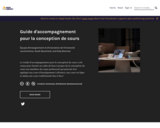
Short Description:
Le Guide d'accompagnement pour la conception de cours a été conçu pour fournir un cadre de base à propos de la conception de cours aux membres du corps professoral qui pourrait être appliqué aux cours d’enseignement à distance, aux cours en ligne et même aux cours traditionnels face à face !
Long Description:
Ce Pressbook a été conçu pour fournir un cadre de base à propos de la conception de cours aux membres du corps professoral qui pourrait être appliqué aux cours d’enseignement à distance, aux cours en ligne et même aux cours traditionnels face à face !
Les lecteurs seront introduits à la stratégie de conception à rebours et recevront des idées pour le développement et planification de leurs cours. Nous avons également fourni des modèles et gabarits de conception de cours ainsi que des activités interactives pour faciliter le processus de conception de cours.
Word Count: 1649
(Note: This resource's metadata has been created automatically by reformatting and/or combining the information that the author initially provided as part of a bulk import process.)

Life in academia is like life in no other profession. The intellectual freedom in conducting research coupled with the ability to positively impact the lives of students through teaching makes it exciting and noble. The road to success in making a difference through knowledge creation (research), knowledge dissemination (teaching) and activities related to both (service) is riddled with many challenges. While PhD programs are designed to teach students the nitty gritty details of conducting research, few focus on the broad issues of how to build a successful research program, how to build an effective teaching portfolio and how to do deal with the many other challenges encountered. Navigating the broader challenges of academia is often accomplished by trial-and-error or ad-hoc mentoring one may receive. Road to Success: A Guide for Doctoral Students and Junior Faculty Members in the Behavioral and Social Sciences by Viswanath Venkatesh provides advice and tools, seeks to help researchers achieve success by navigating through these very challenges.
Tell us how you are using this book If you are a graduate student or prospective graduate student, a course instructor, a scholar conducting research, or another reader please complete the form at https://bit.ly/roadtosuccess_interest
Available formats:
Paperback (ISBN:978-1-949373-73-8)
PDF (ISBN: 978-1-949373-74-5)
The book comprises 20 chapters that are organized into five major sections:
1. Research
2. Managing the PhD program
3. Life after the PhD
4. Teaching and service
5. Broader advice
In addition to the author, both junior and senior scholars have provided contributions to share their own experiences and observations of others who have been successful.
The most important components of the book are the various tools (e.g., how-to advice, checklists) that are provided to help junior researchers head up the road to success and to arm senior researchers to guide junior researchers along the way. The various tools target the following six areas:
1. Building and sustaining a research program
2. Writing a paper
3. Responding to reviews
4. Planning and monitoring through various stages of the PhD program
5. Becoming an effective teacher
6. Achieving work-life balance
About the author:
Viswanath Venkatesh is Verizon Chair of Information Technology at the Pamplin College of Business at Virginia Tech. Please visit http://www.vvenkatesh.com for more information.
Accessibility note:
Virginia Tech Publishing is committed to making its publications accessible in accordance with the Americans with Disabilities Act of 1990. The screen reader-friendly PDF utilizes header structures and includes alternative text which allows for machine-readability.
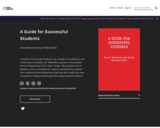
Word Count: 52033
(Note: This resource's metadata has been created automatically by reformatting and/or combining the information that the author initially provided as part of a bulk import process.)

Short Description:
The Guide to Blended Learning is an introduction to using technology and distance education teaching strategies with traditional, face-to-face classroom activities.
Word Count: 27477
(Note: This resource's metadata has been created automatically by reformatting and/or combining the information that the author initially provided as part of a bulk import process.)
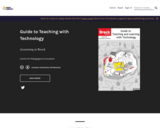
eLearning at Brock
Word Count: 8317
Included H5P activities: 26
(Note: This resource's metadata has been created automatically by reformatting and/or combining the information that the author initially provided as part of a bulk import process.)

eLearning at Brock
Word Count: 8317
Included H5P activities: 26
(Note: This resource's metadata has been created automatically by reformatting and/or combining the information that the author initially provided as part of a bulk import process.)

Short Description:
This starter kit has been created to provide instructors with an introduction to the use and creation of open educational resources (OER). The text is broken into five sections: Getting Started, Copyright, Finding OER, Teaching with OER, and Creating OER. Although some chapters contain more advanced content, the starter kit is primarily intended for users who are entirely new to Open Education. [Version 1.1. Revised September 5th, 2019.]
Long Description:
This starter kit has been created to provide instructors with an introduction to the use and creation of open educational resources (OER). The text is broken into five sections: Getting Started, Copyright, Finding OER, Teaching with OER, and Creating OER. Each chapter is accompanied with learning objectives and most chapters feature interactive elements and opportunities for readers to engage with the text. Although some chapters contain more advanced content, the starter kit is primarily intended for users who are entirely new to Open Education.
Word Count: 18894
(Note: This resource's metadata has been created automatically by reformatting and/or combining the information that the author initially provided as part of a bulk import process.)
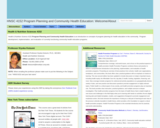
An introduction to concepts of program planning for health education in the community. Program development, implementation, and evaluation of currently functioning community health education programs.

La presente investigación tuvo como objetivo determinar el nivel de relación entre las habilidades perceptivas y el aprendizaje de la matemática de los niños y las niñas de 5 años de una Institución Educativa de Huancavelica, en la educación remota. El diseño empleado fue el correlacional y la muestra lo conformaron 46 estudiantes de 5 años de una institución de educación inicial de Huancavelica. Los instrumentos empleados fueron, la lista de cotejo para cada variable con 30 ítems. Los resultados evidencian que existe relación estadísticamente significativa entre las habilidades perceptivas y el aprendizaje de la matemática en los estudiantes de 5 años de una institución educativa de Huancavelica, en la educación remota. Estos resultados cuantitativos, con un r=0.75, representan una correlación positiva moderada, según el cuadro de índices de correlación de Hernández, Fernández y Baptista (2018)